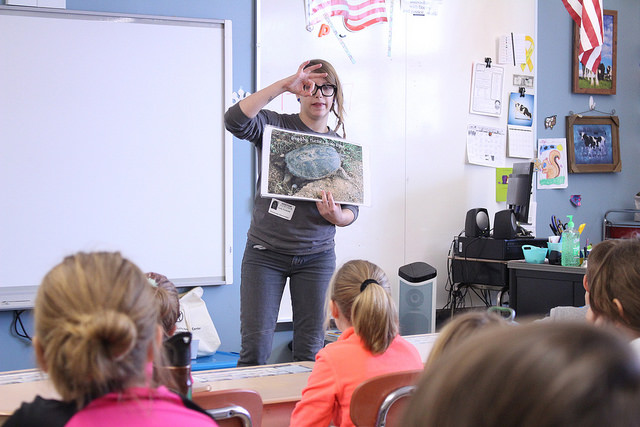Every season has its own sound. Summer is the sound of insects buzzing in the fields, of birds chirping in the wee hours of the morning and of hawks screaming in the sky. Imagining those sounds brings memories of camping sunrises with birds all around in a deafening chorus and of hot humid fields filled with humming insects, scratched legs and cool juicy berries.
Audubon adds more to those summer sounds. There is the sound of laughter and excitement coming from the summer day campers. There is the deafening silence of children so engrossed in what they are doing that all sound ceases. There is the sound of Audubon’s van loading up with teens as they head out for another adventure out in the wilds of the area.
This summer, over 250 children from preschool through high school have registered to come to Day Camp. Some come for one week, some come for two, some children even come to as many camps as they can. They explore, play games, do crafts and learn more about the nature of the area.
Many camps are led by one of the four interns who are themselves learning. They have been learning about natural history and about working with children. They add the sound of excitement, energy and a buzz of youthful passion into the summer.
Fall is full of different sounds. It starts with the reverberation of the first cicada, a long drone in the tree tops that heralds the end of summer. Fall is the sound of honking geese flying overhead, the crunching of leaves and the crisp sound made as you bite into an apple.
At Audubon, fall is the sound of silence. The office feels empty as the interns leave and planning goes into full force. Staff takes some much needed time off. Day Camp is over but the school children have yet to arrive for field trips. There are festivals to organize, dinners to attend, and a school year to get ready for.

Audubon Naturalists spend the winter months in classrooms from the Allegheny National Forest to towns along Lake Erie.
The school year may be Audubon’s busiest time. Starting in the fall, the naturalists leave and head out into schools. Last fall and into the winter, Audubon naturalists went out and visited most of the schools in Chautauqua and Warren County, doing over 900 programs and seeing almost 15,000 children in schools, though some of those visits were to the same student more than once.
A school day generally consists of two to three naturalists each seeing five to six classes of children and teaching them about the nature of the area. It might be a first grade class dissecting a pizza and learning that they eat plants and animals. Or it might be a fourth grade class delving more deeply into how food chains work. Every grade has different concepts and programs that teach valuable lessons to those students.
Winter is another season with a distinct sound. Winter is the sound of howling wind, crunching snow and crows calling overhead as the fly to their winter roosts. For naturalists, it is the sound of the road, as we drive across the area visiting local schools. It is the sound of sipping coffee and windshield wipers.
Naturalists visit schools from the shores of Lake Erie to the heart of the Allegheny National Forest in Pennsylvania. Through snow, wind, ice and cold, Audubon brings natural objects, stories and learning to classrooms throughout the region. Students greet naturalists and the change in pace with enthusiasm.
By the end of winter, spring can never come fast enough. Spring is the sound of Spring Peepers, hordes of migrating birds singing and squelchy mud.
Audubon fills with delight in the spring. Groups of children come in every morning and afternoon to explore the grounds with naturalists and volunteers. They “ooooh” at the baby geese, known as goslings, on the trail and get excited about frogs and generally love exploring the trails. Over 2,300 students come out every spring, with more having field trips in their school yard or local parks.

Audubon Community Nature Center has trails, festivals, play areas and is very active in the local community.
Every season brings new changes to nature and where the Nature Center staff are working. Sprinkle in a few festivals, programs, 5k runs and other things and you have a naturalists year.
Last fall, Audubon officially changed its name to the Audubon Community Nature Center to reflect how active the organization is in the community. Many students in the region see us anywhere from one time to five times a year and thousands of people visit the Nature Center, come to festivals, hike the trails, play in the Nature Play Area and visit Liberty, a permanently injured Bald Eagle, each year.
If you haven’t been out to the Audubon Community Nature Center, I invite you to come down and see all that ACNC has to offer.
Audubon Community Nature Center builds and nurtures connections between people and nature. ACNC is located just east of Route 62 between Warren and Jamestown. The trails are open from dawn to dusk as is Liberty, the Bald Eagle. The Nature Center is open from 10 a.m. until 4:30 p.m. daily except Sunday when it opens at 1 p.m. More information can be found online at auduboncnc.org or by calling (716) 569-2345.
Jeff Tome is a naturalist at the Audubon Community Nature Center.


Recent Comments